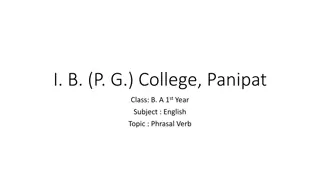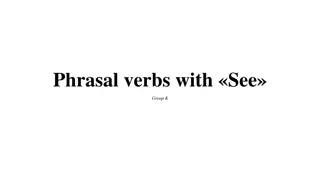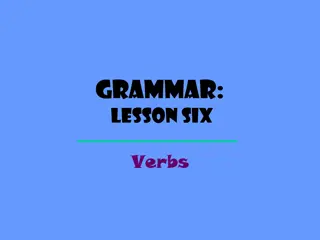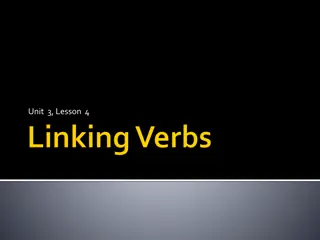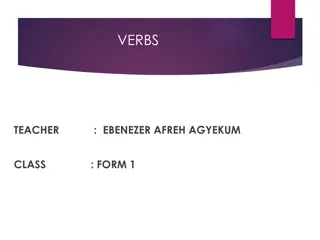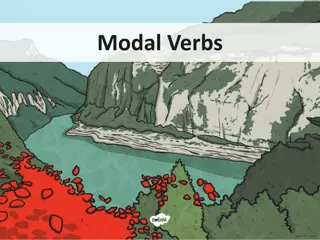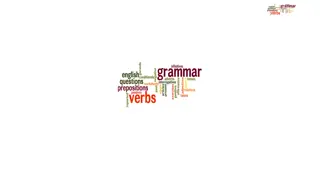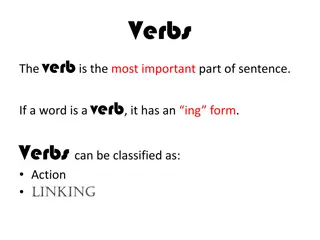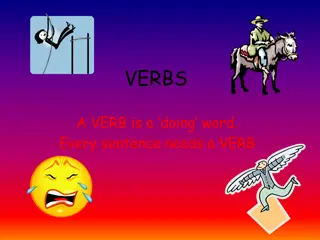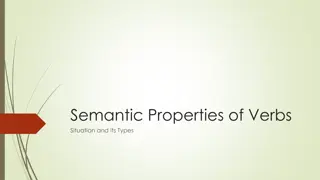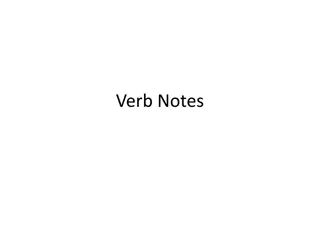Understanding Phrasal Verbs: Classification and Examples
Phrasal verbs are crucial in English, comprising literal, aspectual, and idiomatic categories. They consist of a verb and particle, with idiomatic ones having non-transparent meanings. Examples include "take off" and "set up," each with distinct semantic contributions emphasizing different aspects of the action.
Download Presentation

Please find below an Image/Link to download the presentation.
The content on the website is provided AS IS for your information and personal use only. It may not be sold, licensed, or shared on other websites without obtaining consent from the author. Download presentation by click this link. If you encounter any issues during the download, it is possible that the publisher has removed the file from their server.
E N D
Presentation Transcript
PHRASAL VERBS Prepared By: Shahad Hadi M. Hussain
Phrasal verbs Phrasal verbs are an essential part of spoken and written English at all levels, and nobody planning to master the language can afford to overlook them, it is one of the major difficulties English learners , as well as translators and interpreters, have to contend with. phrasal verbs consist of a verb, followed by an adverbial particle. These adverbials have a less than literal meaning, making the phrasal verb as a whole idiomatic in meaning. The idiomatic meaning that allows the phrasal verb to be replaced with a single word verb.
Phrasal verbs classification Phrasal verbs classification According to Celce-Murcia and Larsen-Freeman (1999: 432 433), phrasal verbs are divided into three categories: 1- literal (e.g., sit down, stand up, pass through, etc.), 2- Aspectual (e.g., read though, set out, write over, etc.), 3- Idiomatic (e.g., chew out, run up, tune out, etc.). They rely on the criterion of compositionality, as opposed to noncompositionality. They hold that literal phrasal verbs are compositional while others are noncompositional. This classification is problematic as sometimes we have phrasal verbs which are noncompositional. Lookup to visit somebody to seek somebody or something out For instance, to look up. to seek informationabout somebody or something in a book According to this classification, its meaning may be restricted to gaze upwards . However, it has many other meanings.
Phrasal verbs classification Phrasal verbs in this study are divided into four categories: 1- Literal 2- Aspectual 3- Idiomatic 4- Polysemous 1- Literal phrasal verbs Literal phrasal verbs are very easy to understand, their meanings are obvious, most commonly, literal phrasal verbs are verbs + directional particles such as, pick up, benddown, put down, pass through, fall down, climb up, and so on. I ran out of the room. I put my keys in my bag. Then I took them out again.
They are phrasal verbs whose meanings are not as transparent as literal phrasal verbs; however, their meanings are not idiomatic either. For example, set up, take off, startout, and so forth. Semantic classes The particle s semantic contribution Examples 1- Inceptive signaling a beginning state take off, set out, start up 2- Continuative emphasizing the continuity of the action hurry along, skim through, think through, work away 3- Iterative emphasizing the repetition of the action turn over and over, write over, think over 4- Completive emphasizing the completion of the action close up, wind up, fade out, wear out, blow out, check over, cut off,
3- Idiomatic phrasal verbs They are phrasal verbs whose meanings are not easy to predict. To put this differently, the meaning of the whole phrasal verb is not related to the meanings of its constituents. Such as, keepup, brush off, zero in on, close in on. Examples: - I just zoned out for a moment - I'll run up a dress for you
4- Polysemous phrasal verbs The final type of phrasal verbs is polysemous. As the name suggests, polysemous phrasal verbs can have multiple meanings, such as check out, lookup, make up, go out, and set off. Examples on the different uses of phrasal verb go off "the pistol suddenly went off" "the fire alarm went off at the first hint of smoke" "if you got in an argument with him, he'd just go off" "milk went off so quickly in hot weather
Not giving full consideration to the unitary nature of these phrasal verbs and relying on the meanings of their constitutes may seriously affect the whole process of understanding, and then, translation. ST: Jehad burst out of the editing suite screaming. He sprinted down the stairs, his head in his hands, his face ripped with anguish. TT 1: . . TT 2: . TT 3: . Here, two phrasal verbs are used in the original text, viz. burst out and sprint down. First phrasal verb to burst out, has been translated into (to go out) once which is different in Arabic than (to burst out) that was used twice. the verb (to go out) does not indicate that the actor of the action Jehad has gone with all haste, therefore translator has followed by (with his top speed), to create a similar mental image. second phrasal verb to sprintout, it has been translated into (to run) followed by (with his top speed) twice, while it has been merged with the verb (to go out) into one verb once.




